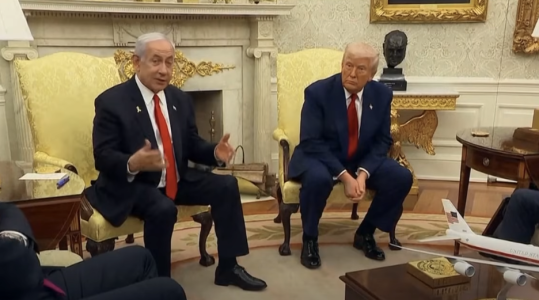The US just unveiled a nuclear bomb 24 times stronger than Hiroshima’s
- Replies 1
As global tensions fluctuate and technological innovation pushes forward, the United States is making major moves in its defense strategy.
One of the most powerful nuclear weapons ever developed by the country is now under construction—months ahead of schedule.
The B61-13 gravity bomb, an advanced addition to the US arsenal, is already turning heads not only for its technical capabilities but also for the speed at which it’s being developed.
Originally scheduled for later this year, the project is now well underway, marking a bold step in America’s evolving nuclear strategy.
At a development cost of $92 million, the B61-13 is the latest in a long line of gravity bombs—nuclear weapons that are dropped from aircraft rather than launched via missiles.
The B61-13 offers a variable yield between 10 and 360 kilotons. To put that into context, the Hiroshima bomb dropped in 1945 had a yield of approximately 12 to 18 kilotons.
The B61-13’s upper limit makes it around 24 times more powerful.
The bomb will first be integrated into the B-2 Spirit stealth bomber and is expected to later be deployed via the new B-21 Raider, currently in development.
Officials at Sandia credited the program's acceleration to “innovative planning” that has allowed engineers and technicians to move through early production phases faster than anticipated.
Also read: Trump plans meeting with Putin–A step towards ending the war?
Both Russia and China have been ramping up their own military modernization efforts.
In response, the US has continued to invest in modern deterrents while also participating in international dialogue around arms control and non-proliferation.
While President Donald Trump has often spoken out about the devastating power of nuclear weapons—calling them “big monsters”—he has also acknowledged the need to maintain a strong defense.
During recent interviews, Trump reiterated his hope that diplomacy will prevail, while still recognizing the realities of the current geopolitical landscape.
Also read: Text trouble–Government officials' blunder sends top-secret plans to an unauthorized recipient via group chat
This includes ongoing discussions with Iran, marking the first formal talks between the two countries since 2015.
Although details remain limited, officials have framed these talks as both a test and an opportunity.
“It is as much an opportunity as it is a test,” Iranian Foreign Minister Abbas Araghchi said. “The ball is in America’s court.”
Back in Washington, US leadership has stressed the dual importance of maintaining a modern defense and pursuing diplomatic pathways that could reduce long-term risks.
With yields many times greater than those used in World War II, the consequences of miscalculation would be catastrophic.
At The GrayVine, we believe staying informed is key. These developments aren’t just distant defense department headlines—they’re deeply tied to national security, international relations, and the future of peacekeeping.
Read more: Emergency funding just got green-lighted by the US House! Here’s what it means for you
 Do you think these advancements are a necessary part of deterrence in today’s world? What are your thoughts on balancing national security with global diplomacy? We invite you to share your perspective with the GrayVine community in the comments below.
Do you think these advancements are a necessary part of deterrence in today’s world? What are your thoughts on balancing national security with global diplomacy? We invite you to share your perspective with the GrayVine community in the comments below.
One of the most powerful nuclear weapons ever developed by the country is now under construction—months ahead of schedule.
The B61-13 gravity bomb, an advanced addition to the US arsenal, is already turning heads not only for its technical capabilities but also for the speed at which it’s being developed.
A Modern Weapon for a New Era
Sandia National Laboratories, a leader in national security research, recently confirmed that production of the B61-13 has been accelerated by roughly 25%.Originally scheduled for later this year, the project is now well underway, marking a bold step in America’s evolving nuclear strategy.
At a development cost of $92 million, the B61-13 is the latest in a long line of gravity bombs—nuclear weapons that are dropped from aircraft rather than launched via missiles.
The B61-13 offers a variable yield between 10 and 360 kilotons. To put that into context, the Hiroshima bomb dropped in 1945 had a yield of approximately 12 to 18 kilotons.
The B61-13’s upper limit makes it around 24 times more powerful.
Building on a Long Legacy
The B61-13 is not starting from scratch—it’s an evolution of the B61-7, part of America’s oldest nuclear weapons program, which began in 1968.The bomb will first be integrated into the B-2 Spirit stealth bomber and is expected to later be deployed via the new B-21 Raider, currently in development.
Officials at Sandia credited the program's acceleration to “innovative planning” that has allowed engineers and technicians to move through early production phases faster than anticipated.
Also read: Trump plans meeting with Putin–A step towards ending the war?
Why Now?
This update to the nation’s nuclear stockpile comes amid rising global security concerns.Both Russia and China have been ramping up their own military modernization efforts.
In response, the US has continued to invest in modern deterrents while also participating in international dialogue around arms control and non-proliferation.
While President Donald Trump has often spoken out about the devastating power of nuclear weapons—calling them “big monsters”—he has also acknowledged the need to maintain a strong defense.
During recent interviews, Trump reiterated his hope that diplomacy will prevail, while still recognizing the realities of the current geopolitical landscape.
Also read: Text trouble–Government officials' blunder sends top-secret plans to an unauthorized recipient via group chat
Diplomacy in Parallel
Amid new development at home, the US has also reopened communication with other nations over nuclear policy.This includes ongoing discussions with Iran, marking the first formal talks between the two countries since 2015.
Although details remain limited, officials have framed these talks as both a test and an opportunity.
“It is as much an opportunity as it is a test,” Iranian Foreign Minister Abbas Araghchi said. “The ball is in America’s court.”
Back in Washington, US leadership has stressed the dual importance of maintaining a modern defense and pursuing diplomatic pathways that could reduce long-term risks.
Power, Responsibility, and Public Awareness
As production ramps up on the B61-13, it raises both strategic and ethical questions. Technological advancements in defense are designed to deter, not deploy—but the mere existence of such weapons underscores the stakes of international diplomacy.With yields many times greater than those used in World War II, the consequences of miscalculation would be catastrophic.
At The GrayVine, we believe staying informed is key. These developments aren’t just distant defense department headlines—they’re deeply tied to national security, international relations, and the future of peacekeeping.
Read more: Emergency funding just got green-lighted by the US House! Here’s what it means for you
Key Takeaways
- The United States has begun production of the B61-13 nuclear bomb, which is 24 times stronger than the Hiroshima bomb, seven months ahead of the initially scheduled time.
- Sandia National Laboratories has announced the fast-tracking of the new bomb under an 'innovative program planning,' aiming to complete the project 25% faster.
- The B61-13 is a gravity bomb with yields ranging from 10 to 360 kilotons, designed for targeted attacks with minimal collateral damage.
- Despite President Donald Trump's avowed aversion to nuclear weapons, America is advancing their production to deter global threats from competitors such as China and Russia.







